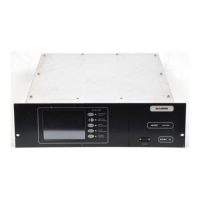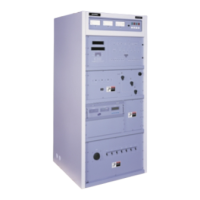2.11.2 Failsafe Interlock: TB1-3,4
When open, the failsafe interlock will mute both visual and aural
RF outputs of the exciter. Normal operation will resume when
closed. This interlock may be used for the remote control system
failsafe interlock, diplexer air switch, or reject load thermal cut
out. Current in the loop should be above 5 mA. The open circuit
voltage of TB 1-3 is +12 volts and TB1-4 is 0 volts.
2.11.3
External Blower Control:
TB4-1,2 (located in bottom of control cabinet)
The external blower control is a set of normally-open contacts
that close when the transmitter is turned on. They may be used
for a diplexer blower, or other contactor control as desired. The
contacts are rated 5 amps, 240 volts AC maximum.
2.11.4
Remote Control I/O:
Three “D” connectors for remote control interface can be
plugged directly into the Harris Sentinel remote control system
ACIO Termination modules. These are:
Transmitter Sentinel
J31 Command in J1 Command out
J32 Status out J2 Status in
J33 Analog out J3 Analog in
Refer to Control Cabinet Wiring Diagram.
2.11.4.1 J31: Command In
The Command inputs are all optocoupled and require a current
source to energize the loop. This can be gotten either within the
transmitter or externally.
The Main Controller board internal current source can be acti-
vated with J20 jumper placed in the 1-2 position, which will
supply +12 volts from the internal supply for the optocouplers.
If J20 is placed in the 2-3 position the optocouplers must be
supplied a voltage on pins 19 & 37 of J31.
The optocouplers require a minimum current of 5 mA, and the
maximum current should be less than 20 mA. Open-circuit voltage
with the internal source (J20 connected 1-2) is +12 volts. Any
externalsource(J20connected2-3)shouldbelessthan36volts.
J31 COMMAND INPUTS:
1 TRANSMITTER ON
2 TRANSMITTER OFF
3 VISUAL POWER RAISE
4 VISUAL POWER LOWER
5 AURAL POWER RAISE
6 AURAL POWER LOWER
7 SELECT EXCITER A (OPT)
8 SELECT EXCITER B (OPT)
9 SELECT MANUAL (OPT)
10 SELECT AUTO (OPT)
11 SELECT COMPOSITE
12-18 NO CONNECTION
20-36 GROUNDS
19 & 37 EXTERNAL SUPPLY
(from J31-19,37; J20 2-3)
The functions marked (OPT) are supplied when the optional
exciter switcher is installed.
Command Functions:
TRANSMITTER ON: Turns transmitter on and enables RF
output.
TRANSMITTER OFF: Turns transmitter off and disables RF
output.
RAISE/LOWER: Raises or lowers visual or aural power output
of the transmitter.
SELECT EXCITER (OPT): Selects exciter “A” or “B” via the
optional exciter switcher.
SELECT MANUAL/AUTO (OPT): Selects the mode of opera-
tion for the exciter switcher. MANUAL mode requires that the
selection be done manually. When in AUTO mode, if an exciter
failure is detected, the switcher will automatically switch to the
alternate exciter if not in a foldback or muted state.
2.11.4.2 J32: Status Outputs
The Status outputs are open-collector drivers with a 100 Ohm
resistor in series and a 24 volt zener (avalanche) diode clamp to
ground.
If the equipment connected to J32 requires a voltage source for
opto-couplers, an internal voltage source of +12 volts can be
made available to the outputs (pins 1 to 16) by placing main
controller optional status jumper J21 in the 1-2 position. When
J21 is in the 2-3 position, an external voltage source must be
supplied to pins 19 & 37.
The open collector stand-off voltage is 30 volts DC, and maximum
current sink is 48 mA. Each output is asserted low for status true
condition.
J32 STATUS OUTPUTS:
20 TRANSMITTER ON
21 LOCAL
22 VSWR FOLDBACK ACTIVE
23 VSWR FAULT
24 MONITOR FAULT
25 CONTROL FAULT
26 EXTERNAL INTERLOCK
27 PHASE LOSS
28 EXCITER MUTE
29 EXCITER FAULT
30 SUPPLY FAULT
31 MODULE FAULT
32 AIR LOSS
33 DOOR INTERLOCK
34 SPARE FAULT
35 NOT USED
36 GROUND
19 & 37 EXTERNAL VOLTAGE
1 to 16 VOLTAGE SOURCE
(for Opto Couplers)
Status Functions:
TRANSMITTER ON: Indicates the state of the transmitter. The
line will be asserted low when the transmitter is on.
Section II - Installation
Rev. C: 8-24-2000 888-2365-001 2-5
WARNING: Disconnect primary power prior to servicing.
